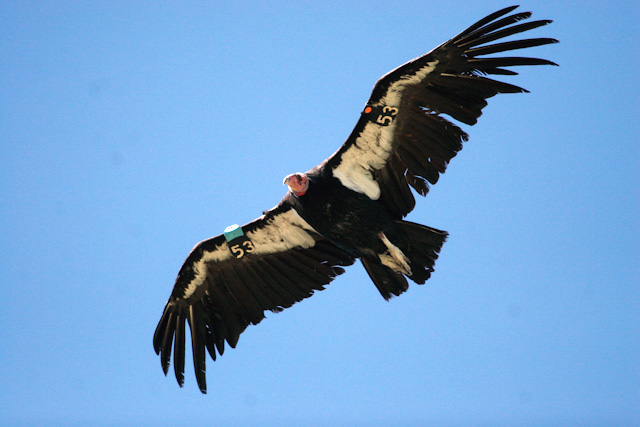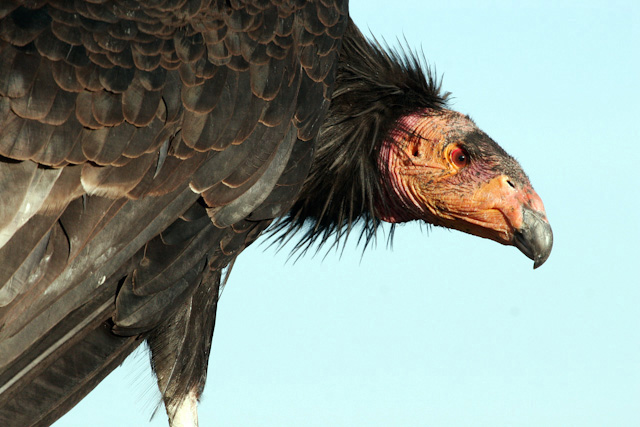
SOUTHERN UTAH—The number of California condors treated for exposure to lead recently dropped to its lowest level since 2005.
Wildlife officials in Utah and Arizona are crediting efforts by hunters – to voluntarily use nonlead ammunition – as a major reason why fewer condors are being affected.

How do you save an endangered California condor? Provide it with a clean and healthy food source.
That’s exactly what hunters in Utah and Arizona have been trying to do over the past few years. And it looks like their voluntary efforts might be paying off.
The number of California condors treated for lead exposure in Utah and Arizona recently dropped to its lowest level since 2005. Between Sept. 1, 2013, and Aug. 31, 2014, a total of 13 condors were treated to counter the effects of lead poisoning. During the same period the previous year, 28 birds were treated. The average over five years had been 26 condors annually.
“This is potentially exciting news,” said Chris Parish, project director with The Peregrine Fund. “We’re hopeful that the decreased measurements of lead exposure are a direct result of the hunters’ actions. With continued effort, we may well see a continuing trend of lower lead levels in coming years.”
Keith Day, a regional wildlife biologist with the Utah Division of Wildlife Resources, also known as UDWR, said condors feed entirely on carrion, that is, dead animals.
“When they eat an animal that died after being wounded by a gunshot,” Day said, “or they eat the entrails left in the field after a hunter has cleaned an animal he or she has harvested, they ingest lead fragments. If hunters use nonlead ammunition, the threat of lead exposure is non-existent.”
To help the endangered condors, the UDWR and the Arizona Game and Fish Department have asked hunters in Southern Utah and northern Arizona to use nonlead ammunition. To offset the cost and encourage participation, both agencies have voluntary programs that provide hunters in those areas with a free box of non-lead bullets.
The voluntary response from hunters has been impressive.

“We’ve operated a lead reduction program in Arizona since 2005,” said Allen Zufelt, condor recovery biologist for the Arizona Game and Fish Department. “Over the past seven years, more than 80 percent of our hunters have chosen to use nonlead ammunition annually in support of the condor program. Many others have removed entrails, which might have lead fragments in them, from the field after a successful hunt.”
Utah’s nonlead program started in 2010. Having a comparable program in Utah may have tipped the scale in favor of the condors.
Day said 55 percent of those who hunted in the Zion hunting unit (where Utah’s nonlead program is focused) in 2013 used nonlead ammunition or removed entrails from the field if they used lead bullets.
“We anticipate that the number of hunters who participate in the program on the Zion unit will continue to grow,” Day said.
Utah hunters can learn more about the state’s lead reduction program — including prizes they can win for participating — at the Utah Division of Wildlife Resources website.
“Hats off to hunters in both states,” said UDWR Director Greg Sheehan. “We’re asking hunters to change a tradition and try something different for the sake of conservation. And they’re stepping to the plate. This type of cooperation is what makes successful wildlife management happen.”
Voluntary nonlead programs will continue in Utah and Arizona this fall, Day and Zufelt said.
The California condor recovery effort in Utah and Arizona is a cooperative program among federal, state and private partners. Those partners include The Peregrine Fund, the Arizona Game and Fish Department, the U.S. Fish and Wildlife Service, the Arizona Strip Field Office of the Bureau of Land Management, Grand Canyon and Zion national parks, the Utah Division of Wildlife Resources, and the Kaibab and Dixie national forests.
Submitted by the UDWR
Resources
- The Peregrine Fund website
- Arizona Game and Fish Department website
- Utah Division of Wildlife Resources website
Related posts
- Utah’s first documented California condor chick peeps forth
- First Utah condor chick born at Zion National Park, specialists believe
- Review of Southwest California Condor program complete, lead-poisoning a concern
- Wildlife officials offer chance to view California Condor
Email: [email protected]
Twitter: @STGnews
yeah, lets get condors all over the lower 48 and Alaska – con everyone into using expensive, scarce, “lead-free” ammo if they want to hunt anything. (maybe we could stop the lead poisoning in Chicago every weekend as well.) methinks the bird is more prone to glycol poisoning from radiator fluid than from a few bullet “fragments”. just easier to pick on hunters with “guns” than automobiles.
Your ignorance is stunning.
Ignorance is bliss around these here parts.
This just means the local gun nuts are shooting at them with steel shot instead of lead shot.
I think this is a good idea. Lead is bad period!!! What about all of the studies through the years about how bad lead is to the human body? It is reasonable that it is not good for the animals or birds either.
Getting to thinking about it, I don’t want to eat an animal that could have lead fragments in it.
Look like a big black turkey. When will open season be on these things? Can you eat them or they just for pure sport shootin?